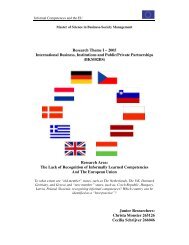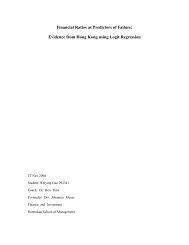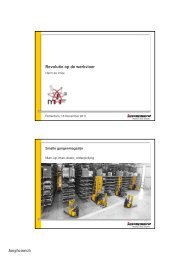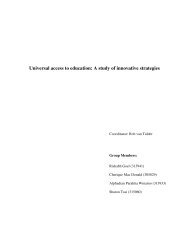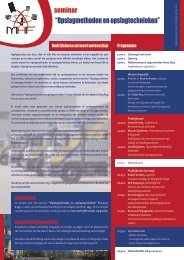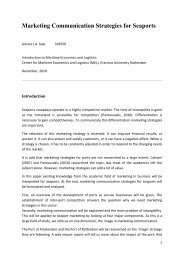here - ERIM - Erasmus Universiteit Rotterdam
here - ERIM - Erasmus Universiteit Rotterdam
here - ERIM - Erasmus Universiteit Rotterdam
Create successful ePaper yourself
Turn your PDF publications into a flip-book with our unique Google optimized e-Paper software.
A validation Study of House of Quality key performance indicators<br />
2.4 SERVQUAL<br />
The SERVQUAL model developed by Parasuraman et al (1985) provides organizations a technology<br />
for measuring and managing service quality (Buttle, 1996). Unlike the quality of goods, the quality of<br />
services cannot be measured objectively by for example the number of defects. Parasuraman et al<br />
(1985) stated that the quality of services is an abstract and elusive construct because of the following<br />
three unique features of services; intangibility, heterogeneity and inseparability of production and<br />
consumption. As objective measures for services are difficult, an appropriate approach for measuring<br />
the quality of the firm is to assess customer’s perceptions about the service. The multi-item scale<br />
SERVQUAL model measures customers perceptions on a quantitative way and can be uses as<br />
diagnostic application to indicate service quality and strengths. The SERVQUAL model defines service<br />
quality as the difference, the gap, between customer’s perceptions of the service and the<br />
expectations of the service. Since its foundation in 1985, extensive research has resulted in a refined<br />
model that consists of 22 items distributed into five dimensions. The 22 items describe aspects of the<br />
following five dimensions of service quality:<br />
Tangibles: physical facilities, equipment, and the appearance of personnel.<br />
Reliability: ability to perform the promised service accurately and dependably.<br />
Responsiveness: willingness to help customers and to provide prompt services<br />
Assurance: knowledge and courtesy of employees and their ability to convey trust and<br />
confidence.<br />
Empathy: caring and individualized attention to customers<br />
To measure the five dimensions of service quality, the SERVQUAL survey consists two sets of 22<br />
statements. The first set measures customer’s expectations for a class of services (e.g. hotels)<br />
w<strong>here</strong>as the second set measures the perceived performance of a particular service provider (e.g.<br />
Hilton Hotel). A score for the quality of service is assessed by subtracting the perceptions score (P) of<br />
the expectations score (E). Positives scores mean that the perceived performance exceeds<br />
customer’s expectations. Negative scores submit to an underperformance in relation to customers<br />
expectations. A score of zero means that t<strong>here</strong> is satisfactory quality.<br />
Parasuraman et al (1988) tested the SERVQUAL model in different service categories (appliance<br />
repair and maintenance, retail banking, long-distance telephone, securities brokerage and credit<br />
cards) and claim that the model consists of generic dimensions and t<strong>here</strong>fore is applicable for use in<br />
a variety of service encounters. Other research studies challenge the dimensionality of the<br />
SERVQUAL model. Buttle (1996) stated that the SERVQUAL dimensions are not universal but the<br />
number and content of the dimensions depend on the context. Within some contexts the domain of<br />
33




